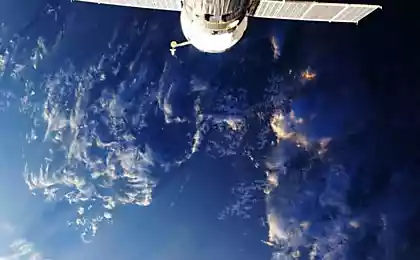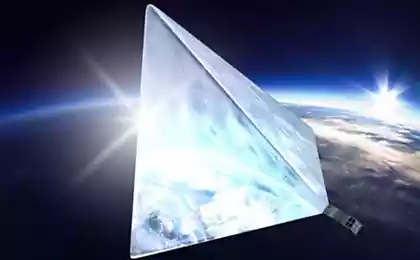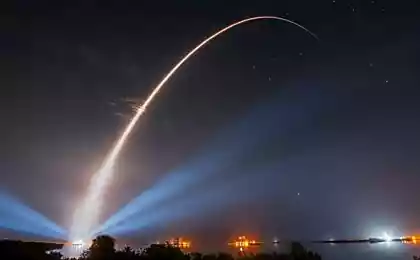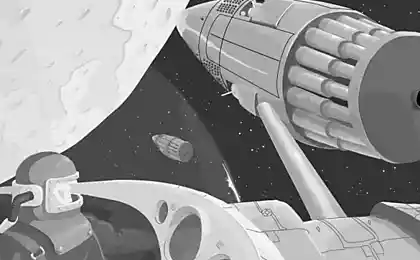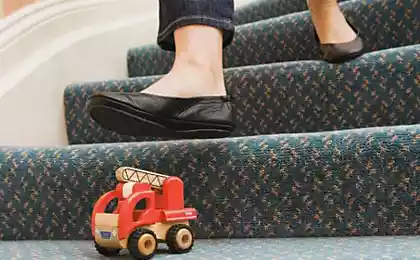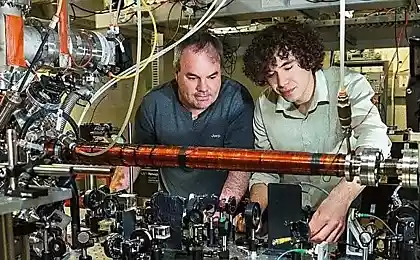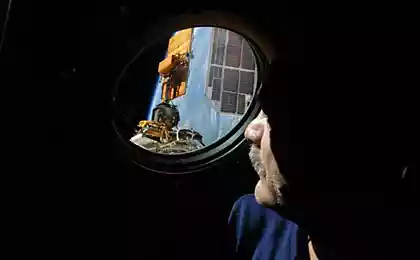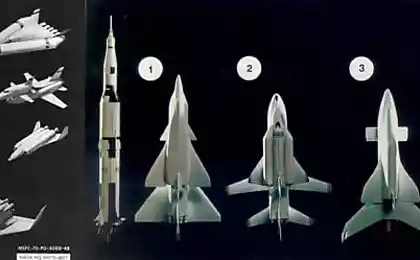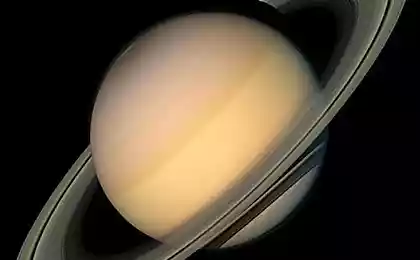692
Physical and biological satellites series "Photon" and "Bion"
Studies of the effect of space flight conditions on living organisms and the physical processes began with the first space flight. Even with Belka and Strelka in flight went mice, rats, seeds and other biological objects. And experiments on space welding carried out another "Soyuz-6" in 1969. It is logical that in 1973 flew the first specialized biocompanion "Cosmos-605" ("BION-1"), and in 1985 - a physical satellite "Foton-1." About ettih spacecraft series, we'll talk today.
and Sweden, and the reaper, and on dude igrets h4> The history of origin of the design of the spacecraft. The fact is that in Korolev OKB-1 was developed proved to be very successful and long-lived chassis. This chassis was used for manned flight under the names "Vostok" and "Voskhod", for photographic reconnaissance - "Zenith", and for the physical and biological research - "Photon" and "Bion»:
I left - "East" in the middle "Zenith", with red lids closed camera lenses, to the right - "Bion». I>
All of these devices have approximately the same mass - 4, 5 - 7 tons are displayed on the launch vehicle family "P-7" and were returning from space lander, which could put a different payload - the astronaut, a set of cameras and equipment scientific experiments. Working hours in orbit - about two weeks. Unification of the chassis reached such a level that some reconnaissance satellites "Zenith" even carrying scientific equipment - on the upper part of the device could deliver a block of extra batteries, or unit "Science" with an experiment that did not need to return to orbit ("Puck" in the photo to the right ). A serial production of reconnaissance satellites, which were claimed by the Ministry of Defence (total was launched more than five hundred "Zenith" of different modifications) meant mastered the basic chassis and the absence of problems with the order and manufacture of devices. "Zenith" of different modifications flew to the middle of the 90s, when they were finally were driven reconnaissance satellites for a new chassis. The disappearance of the basic version of the chassis has led to the fact that "Bion" and "Photon" began to change. Both series received index & quot; -M & quot ;, got another form of propulsion compartment and solar panels instead of chemical current sources. With these changes active lifetime in orbit has increased up to a month or two.
«Bion» h4> Formally, the first "Bion" flew in 1973. However, if desired, can be attributed to the program launch in 1966 «Космоса-110», made on the basis of "Sunrise", which for twenty-two days of flying dogs breeze and crayon. Satellites series "Bion" made a total of 12 flights. 11 of them were committed from 1973 to 1996 in the first version of the device, and in 2013 flew a new "Bion-M". On "Bion" there have been many scientific experiments. For example, "Bion-4" ten rats were flying in conditions of weightlessness, and twenty were in continuous centrifuges, creating artificial gravity. On "Bion" from the sixth to the eleventh flying monkeys:
«Bion-9", 1989, macaque named Bully. i>
Each unit was carrying a number of different experiments. Besides rats and monkeys into orbit launched plants and their seeds, bacteria, cell and tissue culture, fish and amphibians.
«Bion-M №1» h5>
On "Bion-M" in the various experiments were launched Mongolian gerbils, mice, fish, snakes, snails, plants and bacteria, the total number of experiments reached thirty.
The project "biocompanion" has its own channel on YouTube, highly recommend to watch the press conference on the results of the flight. Showing unique footage to work with satellite and biomaterials, and talked about the flight:
You can also see page describing the unit on the site of Roskosmos .
«Photon» h4> The first satellite "Foton" flew in 1985. Apparatus of the first series was twelve, the last of them made a flight in 1999. The second series of devices with an index & quot; -M & quot; for four. "Foton-M1" in 2002 out of luck - because of the failure of the launch vehicle he was put into orbit. But subsequent flying machines, in general, successful. Each "Photon" carried several dozen experiments - where melted materials and grown crystals formed protein molecules work space stove and other experimental production units. A rare "Bion-M" has meant that "Foton-M" were placed and biological experiments.
«Foton-M4» h5>
The fourth satellite of the series "Foton-M" bore the many experiments:
Automatic electro-vacuum furnace "polizon-2" with twelve capsules of different materials, which are heated and crystallize in weightlessness. CALIBER - study of the effect of gravity on the phase transitions of melting / crystallization of gallium alloy. < / VIBROKON-FM - study of the effect of vibrations on heat transfer in liquids. Protein - growing very large crystals of proteins. biocultivator - decomposition by bacteria polyethylene in space flight . MFE - the use of bacteria to produce electricity. GC-04 - the study of sexual behavior, copulation and breeding geckos in weightlessness. Full list online Roscosmos . Material about growing crystals experiment "meteorite" and geckos:
Material after landing:
On the failures and losses h4> It should be understood that when the machine is three decades of experiments, some of them Statistics doomed to failure due to faulty equipment. The situation is, I think, is deteriorating more of the following reasons:
The experiments of this type are as if in a "second tier" of outer space, where there are no procedures to ensure reliability and safety as when sending a man into space. Research teams make unique experiments, the reliability of which can not rise of the serial task. Working with living organisms difficult to work with inanimate equipment. You can reflash a malfunctioning computer probes or rovers, but the first failure kills animals, which later will not be restarted. Even without any failures of the animals die from stress, intragroup conflicts and other reasons. < media can not tell about thirty consecutive experiments. Therefore, select the most pretty (bright, beautiful, interesting) experiment, which only becomes a "star" system, and its failure is perceived as a failure of the entire mission. And humanly understandable frustration of people who have spent years of his life to a failed experiment, goes to mass and again perceived as a complete failure of the mission. Biosatellite. The first satellite has not returned from orbit due to the failure of the engine brake. The second satellite came off successfully, but the research program of the third satellite, designed for thirty days had to stop on the ninth day. And this year, of landing a man on the moon! The program was eventually shut down, including due to the fact that it has become a target for bullying in the media. Sadly the death of gerbils and the refusal of the German aquarium with fish and snails to "Bion" death of geckos in the "Photon", one should not be any global "vsёpropalnyh 'findings. As for the problems of communication and control in the early flight "Photon", that the satellite was in an intermediate elliptical orbit instead of the circular with the height of 500 km, slightly degrade the quality of microgravity, but should not lead to any catastrophic results. Despite the problems, the satellite was successfully pulled to de-orbiting and landing vehicle landed in a given area.
What is the ISS? h4> The inquisitive reader aware of the physical and biological experiments on the ISS might ask - why not conduct these experiments on the ISS, where weightlessness is, and the crew, if anything, will be able to try to fix failure of experimental setups? Indeed, a lot of both physical and biological experiments conducted on the orbital stations. But not for all experiments, this environment is good:
On the ISS is not as "clean" weightlessness as on a dedicated satellite. At the turn of the ISS solar panels vibrate fans and a variety of equipment, the station regularly raises orbit, joints and undock with the ships and can suddenly perform evasive maneuvers by space debris. All of these conditions make the atmosphere of the station poorly suited for experiments requiring exposure to the microgravity conditions. On the ISS has its own flora and there are no conditions of sterility if it is required for biological experiments. ISS drawn on a circular orbit at an altitude of about 450 km. If the experiment need a high or low or elliptical orbit, the ISS for it does not fit. For these reasons, physical and biological satellites, even in small amounts, will continue to exist. Outlook h4> Flight "Bion-M №2» are expected in 2019. It is a common companion series, which, however, are going to run into a circular orbit at an altitude of 1000 km, more than two times higher than the ISS.
But the usual "photon" is no more. He was replaced by machine goes "Back-ICA", which is scheduled to launch with an apogee of 200,000 km. The flight plan is not yet known, depending on the value of the unit will be able to perigee or regularly fly through Earth's radiation belts, studying their effects, or where the perigee is above 20 000 km, to be in conditions similar to an interplanetary flight.
And this - a standalone unit OKA-T ISS, which can be an alternative and the development of satellite "Bion" and "Photon". Standalone module will operate as part of the ISS - regularly download autonomous experiments depart in a "clean" weightlessness, conduct experiments and then dock with the ISS to extract and load the results of new experiments. According to current plans, the module will be launched at the end of 10-ies.
List of references h4> Also used Wikipedia:
project site "biocompanion» . Materials biocompanion: time , two , three . In the "Photon»: time , two , three . For KDPV thanks channel" Star ». Source: habrahabr.ru/post/235877/
Developers Sims 4 joke of "pirates"
A selection of films in the subject Castaneda. Way of the Warrior.

